Equalizing Opportunities to Learn: A Collaborative Approach to Language and Literacy Development in Preschool
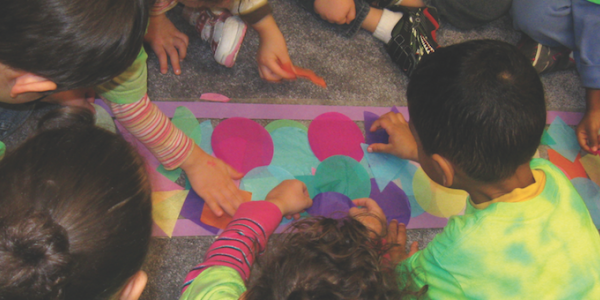
You are here
As little flakes fall from a red crayon onto his forehead, 4-year-old Devondre giggles with delight. He’s on his back, coloring a large poster that is taped to the underside of the art table.
In some preschools, Devondre’s behavior might be seen as eccentric or disruptive. But at his program—in the Stepping Stones Museum for Children—he’s a model student, eagerly participating in an exploration of the challenge Michelangelo faced while painting the ceiling of the Sistine Chapel.
Soon, Devondre’s dusted with flakes, and his arm is tired—and he has a better understanding of the book his teacher read aloud about Michelangelo spending years painting the ceiling. The one thing Devondre wishes he could experience is the scaffolding. It looks like a lot of fun for an artist to climb so high!
Devondre is one of 12 lucky 3- and 4-year-olds at the Early Language and Literacy Initiative (ELLI) Lab School at Stepping Stones Museum for Children, in Norwalk, Connecticut (where all of the authors are teachers, leaders, or mentors). This special program grew out of a citywide commitment— by 70 nonprofit and community organizations—to increase equity in children’s learning opportunities and outcomes. Shaped from the ground up, the framework for this program intentionally incorporated the latest research-based theory and practice in order to create the enriched preschool education that has been shown to produce substantial long-term gains in learning and development (Heckman 2011). ELLI has expanded to three prekindergarten classrooms in the Norwalk Public Schools and one prekindergarten, one infant, and one toddler program in Fairfield, Connecticut.
The ELLI Lab School’s curriculum and instruction, which the authors had a role in creating, is based on Vygotsky’s concept of language and learning. Vygotsky understood that language develops through social interactions through which those with more knowledge teach those with less experience the skills, values, and knowledge needed to be productive members of their community (Vygotsky 1978; Daniels 2005). Vygotsky saw learning as a process of guided discovery in which more experienced community members provide support to purposefully stretch children in their zones of proximal development (which are just beyond what they can currently do independently). As children’s language develops, so does their ability to engage in and initiate positive social interactions; they “can reflect better on their own thinking and behavior and reach greater levels of control and mastery over their own behavior” (Winsler, Fernyhough, & Montero 2009, 4).
Although the ELLI framework includes several areas of focus, in this article we explore two of the most important: providing complex classroom environments and supporting language development through learning content. We intentionally incorporate a language and/or literacy objective into every experience the children have throughout the day.
Scaffolding knowledge by creating complex settings
Just like exhibits in the children’s museum where our school is located, the learning centers in our classrooms change to reflect each project the children undertake. This complexity and change in the environment keeps the children and the teachers interested and engaged in their learning. More important, evidence suggests that environmental complexity fosters intellectual growth: “By providing a more cognitively stimulating and demanding environment, we raise the IQ of those who engage with it” (Protzko, Aronson, & Blair 2013, 29). But note that complex environments are not simply highly decorated environments. Visuals that are not connected to learning objectives can be distracting and decrease learning (Fisher, Godwin, & Seltman 2014). Inspired by the museum, we value beauty and an uncluttered feel. Along with the children, we create intellectually stimulating environments that enrich and reflect their learning.
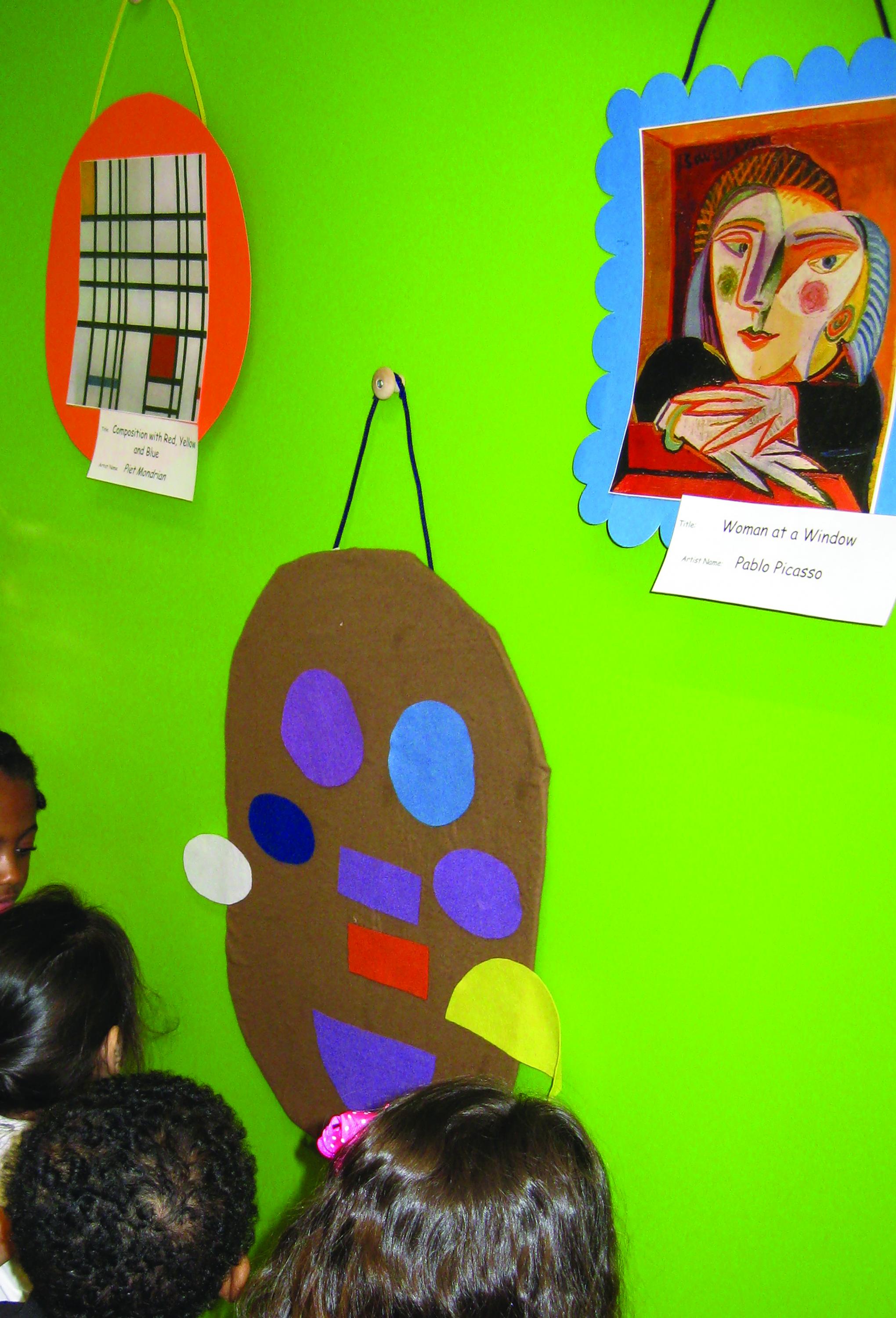
Some of our ever-changing centers emerge from exhibits in the museum. Other projects emanate from the seasons, available resources, or the children’s or teachers’ interests. What makes our projects different is that the teachers intentionally link each one—throughout the day, as well as throughout the year—to a reappearing “big idea.” This enables the children to experience a spiraling curriculum and deeper learning.
For example, under the big idea of animal and human adaptation, teachers linked projects on farmers’ markets, the Arctic and Antarctic, community helpers, rainforests, and dinosaurs. Using materials like boxes and contact paper, the children and teachers constructed related environments—like a mini rainforest and a polar landscape—in the classroom. Connecting these environments through a big idea such as adaptation creates a framework that supports participants’ imaginations, develops their knowledge, and enhances their abilities to draw inferences (Paradise & Rogoff 2009). Building these connected environments offers a wealth of opportunities to dive deeper into the content, inspire greater curiosity, and use related vocabulary.
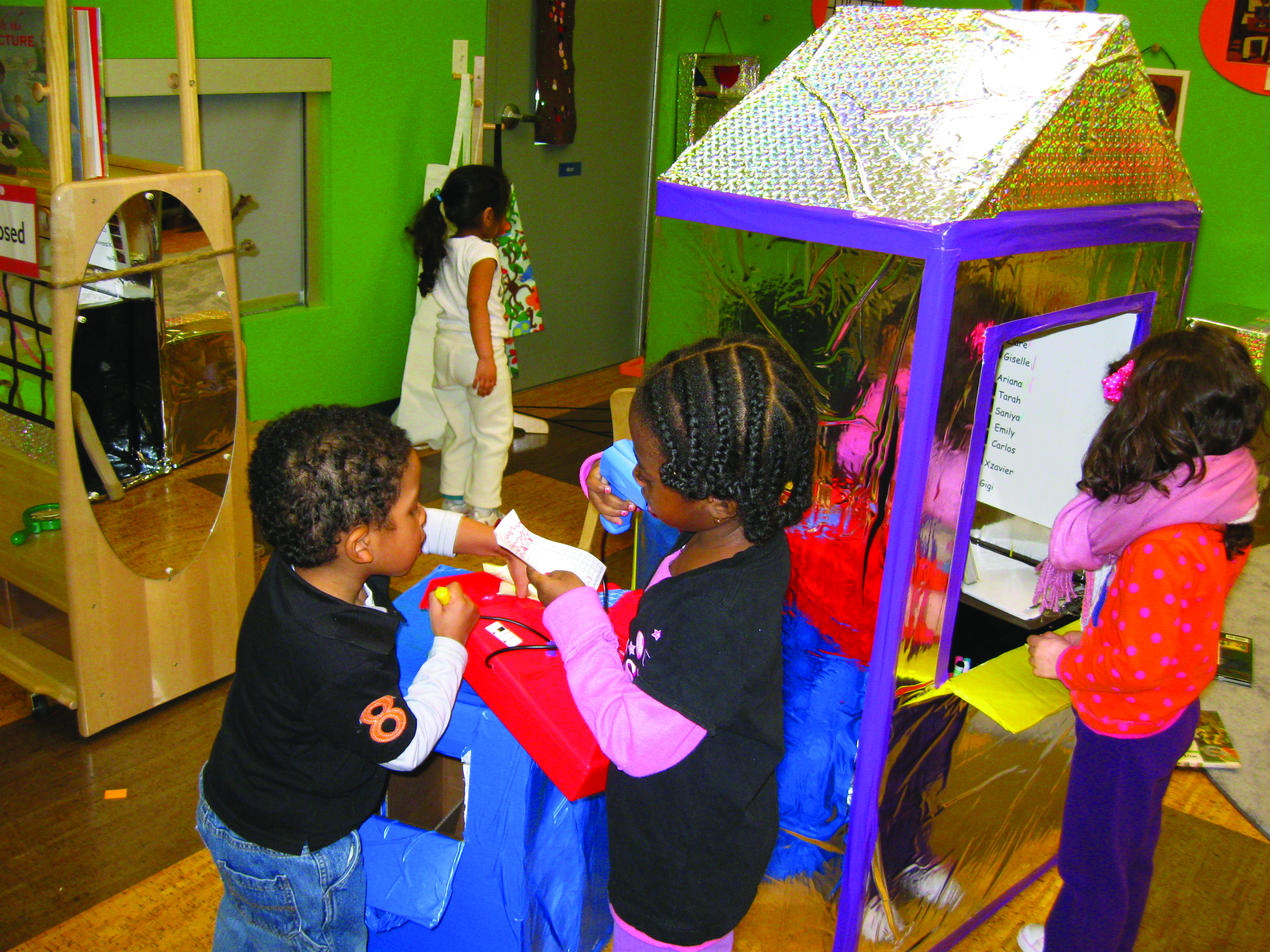
Standing at the ticket window in the children’s classroom mini-museum, Sayo is eager to sell tickets and guide visitors to her favorite exhibits—including those that feature her artwork. Along with her classmates, Sayo has spent the past two months visiting a traveling exhibit at the Stepping Stones Museum and building a mini-museum showcasing multiple kinds of child-created art—sculptures, family and self-portraits (signed!), and tissue paper stained-glass windows.
The mini-museum was one of the children’s most complex and rewarding learning environments. While the children took the lead, the teachers provided support and materials without interfering with the children’s play. Following best practices (like asking thought-provoking, open-ended questions), they guided play toward instructional goals (Roskos & Christie 2009).
A wonderful example of teachers supporting complex play occurred when the children wanted to recreate a museum café. The children sat down at the table, waiting to be served! A teacher asked them who would prepare and serve the food, which acted as a gentle suggestion that the children take on the roles of chefs and servers. When the teachers became participants in the children’s play, the complexity of the environment increased, the children sustained their curiosity, and the children expanded their knowledge of how cafés operate. This added learning about cafés emerged from the children’s desire for an authentic mini-museum. The teachers’ initial objectives—which were also fully met—were for the children to learn rich background knowledge about art and its special vocabulary. The café play was an extension of other project-based experiences that occurred throughout the day.
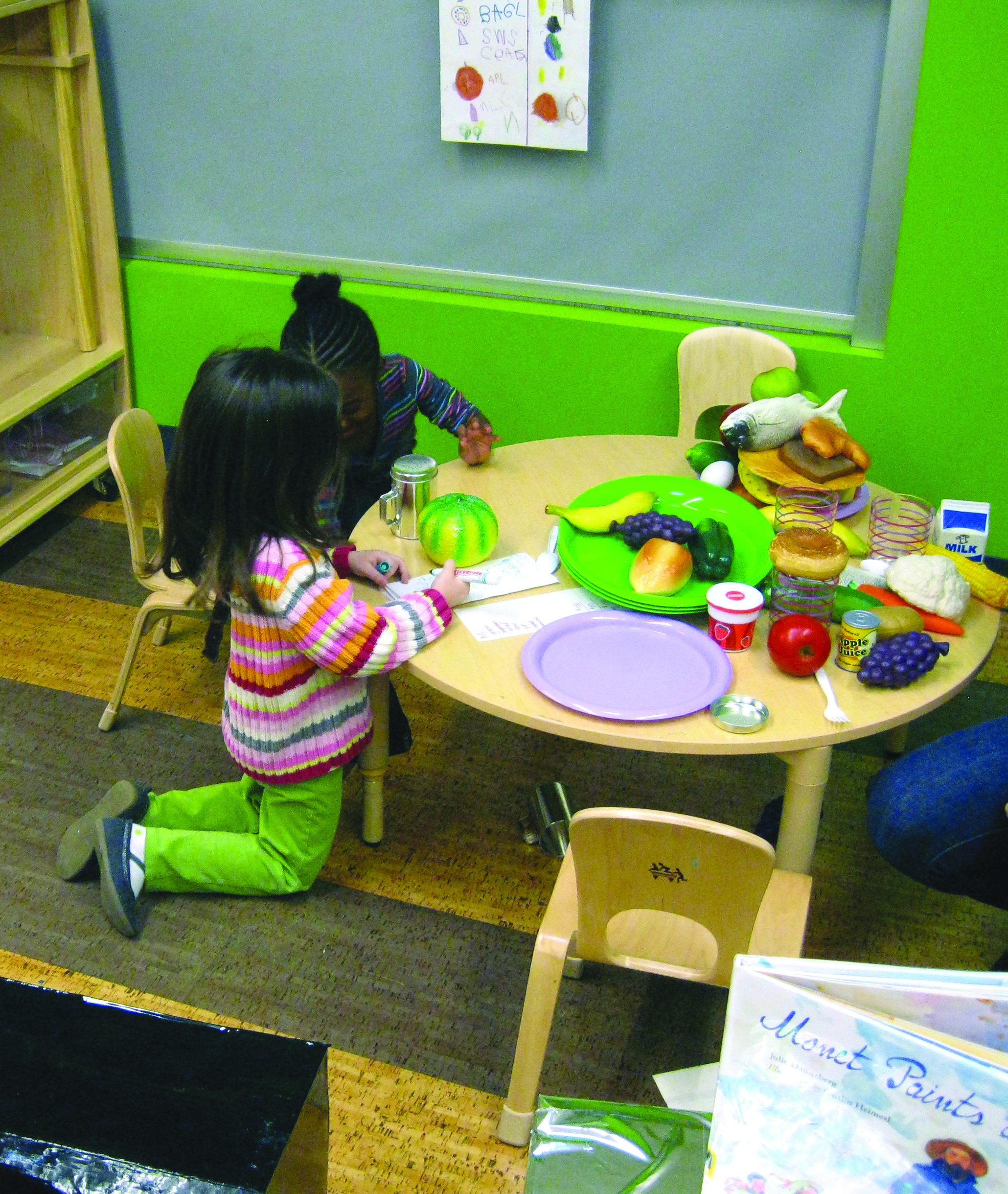
For example, while creating their mini-museum, children learned about Picasso’s painting Woman by the Window. A teacher hung a print of it in the minimuseum and brought in small tables with felt shapes and a large felt board. With a little support, children sorted the shapes and used them to create their own Picasso-style self-portraits. At other times, children and teachers painted portraits, created three-dimensional sculptures, and built an edible totem pole. The integration of these different experiences during the mini-museum project provided multiple opportunities to increase the children’s content knowledge and expand their vocabularies related not only to art but to math and science, too.
Focusing on vocabulary and language structure
The following scenario began in the imagination of one child, who pretended to be Michelangelo, and was extended through conversations with teachers. Eventually all the children joined this imaginative play.
As a group of children serve up and dine on pretend lunches in the mini-museum café, another child takes on a new role with a curly beard, paint-stained fingers, and an old smock.
“Who are you?” asks Anton.
“Where did you come from?” adds Xinyi.
With the teachers joining the pretend play, the child introduces himself as Michelangelo and confirms that he is not a local artist (local is a new vocabulary word that was intentionally and explicitly taught to the children). “I’ve flown here from Italy. I needed a break from all of that ceiling painting,” he says, grabbing his arm, his face comically pained. “Also, someone told me the food was very good here—and the art.” Michelangelo points to the children’s colorful paintings and collages hanging in the exhibit.
Two servers jump to ask for his order when he takes a seat.
Michelangelo talks about his latest project as his cucumber and tomato dish cooks.
When the bill comes, he scribbles out his signature (another vocabulary word), bids the children goodbye, and vanishes from the classroom as quickly as he appeared.
For the rest of the day, the children are abuzz about the visit.
This kind of creative child-initiated, multifaceted play emerged frequently, thanks to the complex physical and rich linguistic environment the teachers cultivated. Other vocabulary words integrated into this unit included temporary, permanent, symmetry, edible, nonedible, three-dimensional, and self-portrait. These words, along with child-friendly definitions, were posted throughout the classroom to remind the teachers to use the words. As soon as the children understood a concept, the teachers intentionally used sophisticated synonyms multiple times and in multiple contexts. That way, the children learned the words naturally and then used them in the classroom and at home.
While projects shift and expand according to the children’s suggestions, one thing that remains constant is the teachers’ drive to use new, challenging words during play and throughout the day so children learn and begin using the new vocabulary. When they use these words frequently in different contexts and environments, the words are more likely to stick. The teachers take every opportunity to reinforce the targeted vocabulary, concepts, and language skills naturally, using teachable moments during circle time and transitions—and even while eating lunch.
Since the ELLI Lab School’s mission is to create equitable learning opportunities and outcomes by maximizing early language and literacy development, much of the teachers’ professional development is devoted to studying the developmental pathways children take to acquire academic language. The ELLI curriculum is designed so that all the projects are linked by a big idea, which means we are able to plan in advance the academic language and vocabulary that we intend to help the children learn each year. This enables the children to experience multiple exposures to the vocabulary in multiple contexts, which is necessary for attaining deep knowledge of the language.
Pairing Art and Literature
Each day in the ELLI Sphere (our name for circle time), a teacher reads a book aloud. The book is a springboard to a small group activity that builds math, science, or literacy skills (and sometimes all three). For example, after reading the book Look! Look! Look! at Sculpture, by Nancy Elizabeth Wallace, the teacher assisted the children in making observations about an elephant sculpture. Through a guided discussion, the teacher helped the children point out the sculpture’s details, including the number of legs, ears, and trunks the elephant had. As a group, the children created a large sketch of the elephant—each child drew a section.
The experience continued in small groups in which children had the opportunity to draw their own complete sketches of the elephant. Teachers encouraged children to label their drawings using invented spelling. The following day, another layer was added to the experience as the teachers invited the children to create sculptures based on their sketches. Like the work of professional artists, the children’s work was then displayed in their classroom art museum.
Here is a list of the children’s books used during the visual arts project in which the children created the mini-museum:
- A Blue Butterfly: A Story about Claude Monet, by Bijou Le Tord (1995)
- Color Zoo, by Lois Ehlert (1997)
- A Day with No Crayons, by Elizabeth Rusch, illus. by Chad Cameron (2007)
- The Dot, by Peter H. Reynolds (2003)
- Hugo & Miles in I’ve Painted Everything!, by Scott Magoon (2007)
- I Ain’t Gonna Paint No More!, by Karen Beaumont, illus. by David Catrow (2005)
- It Looks Like Spilt Milk, by Charles G. Shaw (1998)
- Look! Look! Look! at Sculpture, by Nancy Elizabeth Wallace, with Linda K. Friedlaender (2012)
- Lots and Lots of Zebra Stripes: Patterns in Nature, by Stephen R. Swinburne (2002)
- Mouse Paint, by Ellen Stoll Walsh (1995)
- Shadow, by Suzy Lee (2010)
- What Makes a Rainbow?, by Betty Ann Schwartz, illus. by Dona Turner (2000)
- White Rabbit’s Color Book, by Alan Baker (1999)
For example, the yearlong big idea of animal and human adaptation that connected our learning about dinosaurs, farmers’ markets, and other topics focused on academic vocabulary, such as human, habitat, adapt, adaptation, needs, wants, herbivore, carnivore, predator, and prey. The ELLI teachers have been taught why academic vocabulary and language knowledge are essential to reading comprehension in the later grades: background knowledge is a primary driver of comprehension. The more children know about a topic (including conceptual knowledge and related vocabulary), the better they will understand a text on that topic (Willingham 2009). Knowing this, teachers intentionally design experiences so that children have opportunities to practice academic vocabulary and language forms (i.e., syntax) in their zones of proximal development.
Another example is sorting, a popular preschool experience used to teach children to classify objects and one that can also be used to develop academic language: “This paintbrush is big. This one is even bigger, and this is the biggest paintbrush of them all!” This adds both academic language and mathematics knowledge-building components to the sorting experience. One of the most important features of the ELLI model is that a language and/or literacy objective is intentionally but naturally incorporated into every experience. If we are serious about equalizing children’s opportunities to learn, we must ensure all children develop the academic language and literacy that are the keys to learning in later grades (and throughout life).
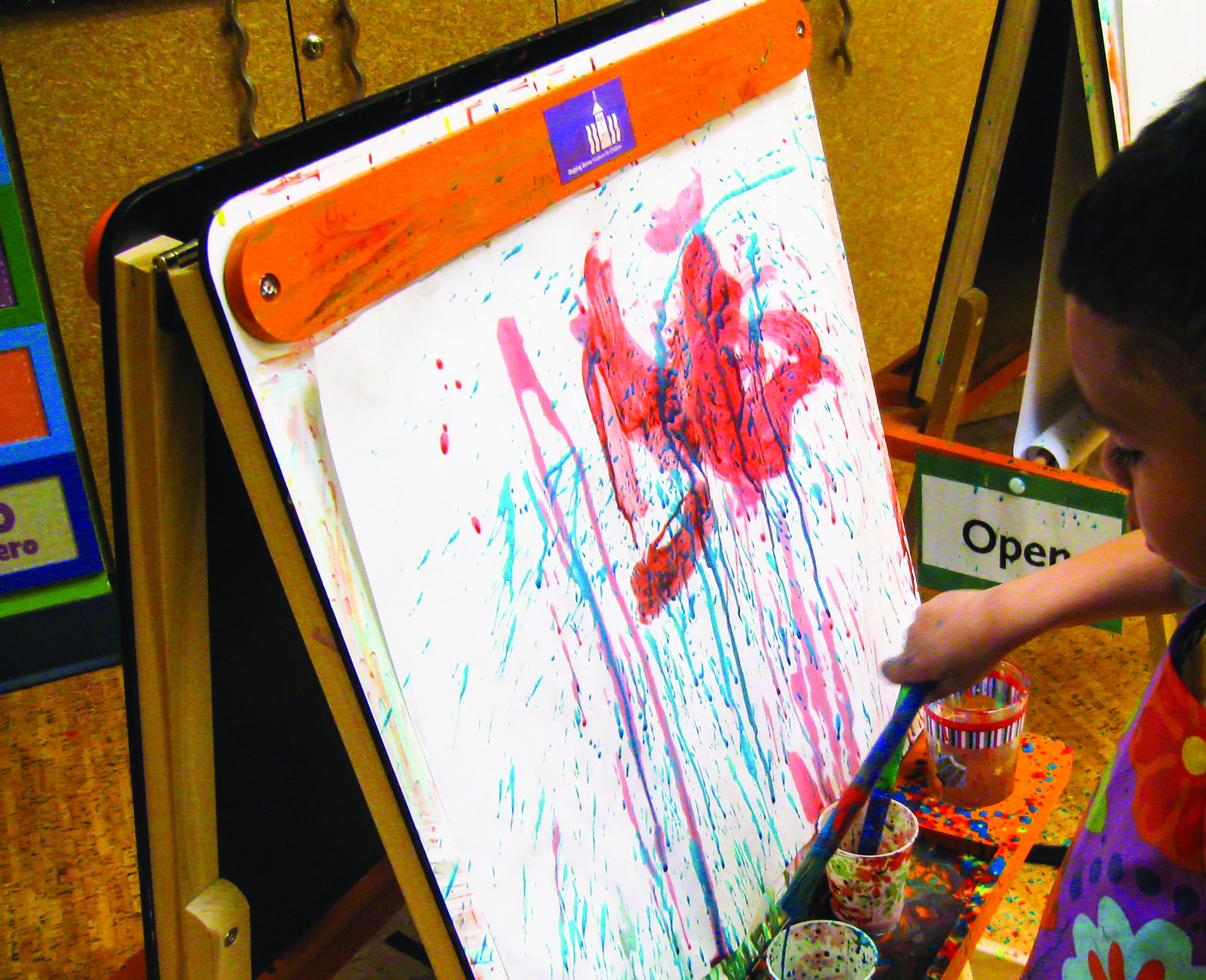
As research has shown, children’s opportunities to hear and learn language tend to vary dramatically, with children from families with higher incomes and more education hearing millions more words during the first few years of life than their less privileged peers (Hart & Risley 2003). Converging evidence has demonstrated that academic success is highly dependent on vocabulary and background knowledge. (For seminal studies, see Beck, Perfetti, & McKeown 1982 and Pearson, Hansen, & Gordon 1979.) Play is a perfect vehicle for incorporating both vocabulary and content knowledge into every learning experience.
While many children become adept at sounding out words by third grade, some experience a fourth-grade slump because they struggle to make the transition from learning to read to reading to learn (Chall & Jacobs 2003). These children may be good at decoding, but many have limited academic knowledge and vocabulary—so they don’t know the meanings of many of the words they decode. That is the reason building vocabulary and background knowledge is so important throughout early childhood. When children with large oral vocabularies learn to read, they rarely have comprehension problems.
When the teachers at our school learned about the literacy pathways the children would follow in the later grades, they recognized the importance of integrating multiple ways of experiencing new vocabulary and increasing knowledge. They became motivated to create complex and content-rich play settings that incorporated as many sophisticated vocabulary words as possible (Roskos & Christie 2009).
Conclusion
The formal and informal data we have collected that demonstrate the children’s language and literacy development and learning are very encouraging. The strength of the data has enabled us to expand into several model classrooms across Norwalk. Since the expansion sites can’t also be in children’s museums, we have brought traveling museum exhibits to the new sites to stimulate the development of complex, playful learning environments in each classroom. Providing high-level language and literacy professional development weekly has been essential to the success of the program. The teachers from the ELLI Lab School now support teachers in several model classrooms, ensuring equally strong results across sites.
References
Beck, I.L., C.A. Perfetti, & M.G. McKeown. 1982. “Effects of Long-Term Vocabulary Instruction on Lexical Access and Reading Comprehension.” Journal of Educational Psychology 74 (4): 506–21.
Chall, J.S., & V.A. Jacobs. 2003. “The Classic Study on Poor Children’s Fourth-Grade Slump.” American Educator 27 (1): 14–15, 44.
Daniels, H., ed. 2005. An Introduction to Vygotsky. 2nd ed. New York: Routledge.
Fisher, A.V., K.E. Godwin, & H. Seltman 2014. “Visual Environment, Attention Allocation, and Learning in Young Children: When Too Much of a Good Thing May Be Bad.” Psychological Science 25 (7): 1362–70.
Hart, B., & T.R. Risley. 2003. “The Early Catastrophe: The 30 Million Word Gap by Age 3.” American Educator 27 (1): 4–9.
Heckman, J.J. 2011. “The Economics of Inequality: The Value of Early Childhood Education.” American Educator 35 (1): 31–35, 47.
Paradise, R., & B. Rogoff. 2009. “Side by Side: Learning by Observing and Pitching In.” Ethos 37 (1): 102–38.
Pearson, P.D., J. Hansen, & C. Gordon. 1979. “The Effect of Background Knowledge on Young Children’s Comprehension of Explicit and Implicit Information.” Journal of Literacy Research 11 (3): 201–9.
Protzko, J., J. Aronson, & C. Blair. 2013. “How to Make a Young Child Smarter: Evidence from the Database of Raising Intelligence.” Perspectives on Psychological Science 8 (1): 25–40.
Roskos, K.A., & J.F. Christie. 2009. “Play in the Context of the New Preschool Basics.” Chap. 5 in Play and Literacy in Early Childhood: Research from Multiple Perspectives, 2nd ed., eds. K.A. Roskos & J.F. Christie, 83–100. New York: Routledge.
Vygotsky, L.S. 1978. Mind in Society: The Development of Higher Psychological Processes. Ed. & trans. M. Cole. Cambridge, MA: Harvard University Press.
Willingham, D.T. 2009. Why Don’t Students Like School? A Cognitive Scientist Answers Questions about How the Mind Works and What It Means for the Classroom. San Francisco, CA: Jossey-Bass.
Winsler, A., C. Fernyhough, & I. Montero, eds. 2009. Private Speech, Executive Functioning, and the Development of Verbal Self-Regulation. New York: Cambridge University Press.
Photographs: courtesy of Kate Delli Carpini
Laura B. Raynolds, PhD, is an associate professor in the graduate reading program at Southern Connecticut State University, in New Haven. She has worked extensively with early childhood teachers and researches on the early literacy skills of bilingual learners. [email protected]
Margie B. Gillis, EdD, is the cofounder of the Early Language and Literacy Initiative Lab School (ELLI) at Stepping Stones Museum for Children, president and founder of Literacy How Inc., and a research affiliate at Fairfield University and Haskins Laboratories. [email protected]
Cristina Matos is the education director for the ELLI, a partnership between Stepping Stones Museum for Children and Literacy How. She has worked in early childhood education programs for more than 25 years. Cristina oversees all the ELLI classrooms, creates ELLI curriculum, designs ELLI environments, and leads teacher professional development. [email protected]
Kate Delli Carpini, former program director for the ELLI, created dynamic education experiences for children as part of the museum team beginning in 2008. [email protected]
